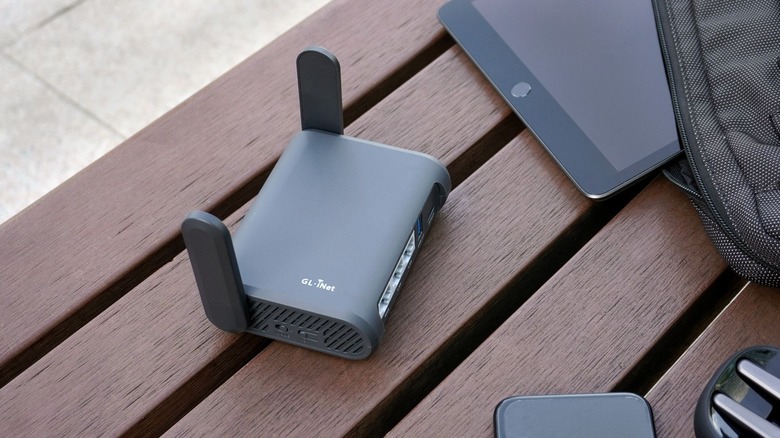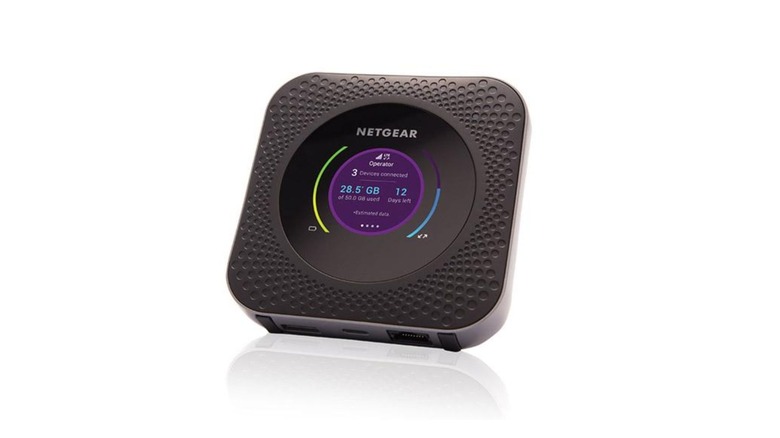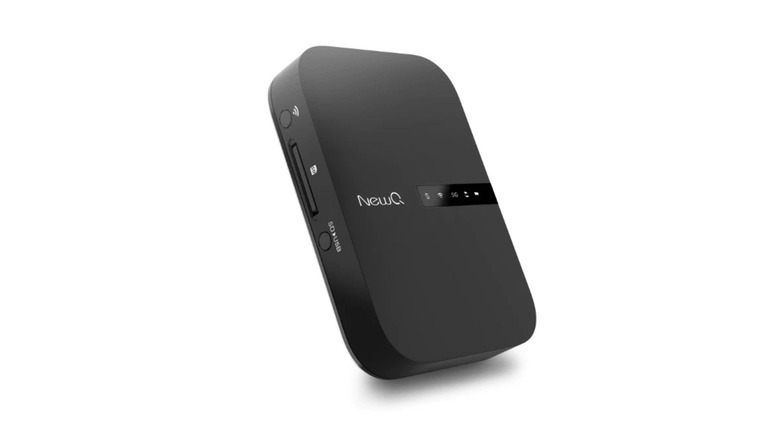7 Wireless Travel Routers That Will Keep You Connected On The Go
If you find yourself traveling often, you might want to buy a portable hotspot or a travel router — or both! A travel router is just like the Wi-Fi router you have at home, but it's smaller and easier to fit inside a suitcase or a backpack. Sometimes, a travel router might even be small enough to slip into a pocket.
There are many perks to investing in a travel router if you find yourself in lots of airports and hotels, but here's the biggest: You don't have to keep adding all your devices to new Wi-Fi networks. Typically, when you get to a new hotel or an airport, you have to connect to the public Wi-Fi network if you don't want to deplete your mobile data.
When you connect to some hotel and airport networks, you often have to provide information about yourself, like your name or the room you're staying in. With a travel router, you only need to connect the travel router to the new Wi-Fi network, and all your devices — smartphone, tablet, laptop, and so on — automatically connect to the travel router. If you travel often with your family members, they can all connect to the travel router as well, depending on how many total devices it supports.
Travel routers also make it appear as though there's only one device connected to the network, rather than the unique IP addresses of all your devices. This can come in handy if you ever need to pay for Wi-Fi by device, like you sometimes do on airplanes, because you'll only need to pay a single fee.
When you're done traveling, you can still utilize a travel router around the home. You can use it to extend the range of your existing home router or to increase speeds in a specific room.
What to look for in a wireless travel router
Doing a quick search for "wireless travel routers" populates a ton of results. Some are super affordable, while others seem ridiculously expensive. How can wireless travel routers differ so much in price? Well, it all comes down to what each travel router is offering in terms of its technical specifications and features.
When you're looking to buy a travel router, you'll want to pay attention to the Wi-Fi standard and frequency bands it supports, available ports, and overall battery power, if any. It's also important to see what the travel router offers in terms of security and privacy, as well as whether you can use it when you're at home and not traveling.
The latest, fastest Wi-Fi standard is Wi-Fi 6 (also referred to as 802.11ax), but you'll pay a pretty penny for a travel router that supports Wi-Fi 6. Stepping down to Wi-Fi 5 is perfectly fine, and even dropping to Wi-Fi 4 isn't too bad for basic internet needs. Then, many travel routers only offer a single 2.4 GHz band, but it's better to invest in one that has at least a single 5 GHz band or a dual-band setup, with one 2.4 GHz band and one 5 GHz band.
As far as ports go, just make sure there are enough ports to satisfy your specific needs. You'll often find Ethernet ports or USB ports on a travel router, but it's up to you to decide how many you need for your devices.
Then, many wireless travel routers don't run off battery power. Instead, you need to plug it in via a power adapter or through a USB port on your laptop. If you can afford a travel router that doubles as a portable power bank, it's the smarter option, especially when smartphones always seem to be close to running out of battery while traveling.
GL.iNet Slate AX (GL-AXT1800)
GL.iNet's Slate AX wireless travel router is a premium Wi-Fi 6 option that's rich in features and has a strong focus on user security. Also referred to as the GL-AXT1800 router, the Slate AX offers dual-band support. The 2.4 GHz band can reach speeds up to 600 megabits per second, while the 5 GHz can reach speeds up to 1,200 megabits per second. You can connect up to 120 devices simultaneously between the two bands.
On top of speedy wireless connections, the Slate AX travel router also comes equipped with one WAN Ethernet port and two LAN Ethernet ports — all three are Gigabit Ethernet ports. Then, there's one USB 3.0 port, one USB-C power port, and a microSD card slot that supports up to 512 gigabytes. You can use it as a secure router on the go in hotel rooms or airports, or you can take it home to act as a Wi-Fi extender.
Though it doesn't come with built-in battery power, the Slate AX from GL.iNet comes with many security protocols to help keep you and your data safe. It comes with multiple layers of security, including OpenWrt pre-installed, WPA3 protocol, AdGuard Home, IPv6, and support for over 30 different VPN services. Everything is powered by the IPQ6000 1.2 GHz quad-core processor, and it's wrapped up in a compact package slightly bigger than the size of your hand.
TP-Link TL-WR902AC
TP-Link is a well-trusted brand in the realm of wireless routers, and the TL-WR902AC is the world's first AC750 travel router. Speedy AC750 Wi-Fi 5 is made possible over dual 2.4 GHz and 5 GHz bands. The 2.4 GHz band offers speeds up to 300 megabits per second, while the 5 GHz band can reach speeds up to 433 megabits per second.
It's also incredibly compact and can easily fit inside your pocket, purse, or backpack. Despite its small size, the TL-WR902AC still offers essential ports. There's one 10/100 megabits-per-second Ethernet port and one USB 2.0 port. Through the USB port, you can charge a single device or connect a storage drive to share access to files, download movies, and backup photos.
The TL-WR902AC is equipped with IPv4 and IPv6 internet protocols, Wi-Fi encryption, an SPI Firewall, and guest networks on each band. Powered by a single-core CPU and priced at less than $50, this travel router can act as a router and a hotspot while you're traveling, and then as a Wi-Fi range extender and an access point when you get home.
GL.iNet Mango (GL-MT300N-V2)
The GL-MT300N-V2 router from GL.iNet, more aptly referred to as Mango, is small but mighty. It's incredibly compact and lightweight and stands out from the crowd with its bright yellow outer shell. Despite its tiny exterior, there's a lot going on inside the Mango router for only about $30.
Powered by its new chip — the MT7628NN from MTK — and 128 megabytes of RAM, the Mango is able to provide better Wi-Fi connections and faster OpenVPN encryption. The Mango also has a built-in firewall and supports WireGuard, DNS over TLS, and over 30 different VPN services in total. There's only one 2.4 GHz band, but it can reach speeds up to 300 megabits per second, which is perfect for internet browsing and occasional streaming.
For ports, there's one WAN Ethernet port, one LAN Ethernet port, one USB 2.0 port, and one micro-USB power port. You can use a laptop, power bank, or a standard 5V/2A DC adapter as a power supply for GL.iNet's Mango travel router. You can connect the Mango to the internet through an Ethernet cable, a repeater, a USB modem, or tethering via your smartphone.
NETGEAR Nighthawk M1 4G
The Nighthawk M1 from NETGEAR is the world's first gigabit-class LTE mobile router, offering Wi-Fi 5 speeds up to 150 megabits per second over dual 2.4 GHz and 5 GHz bands, as well as 4G LTE mobile speeds with a compatible SIM card. Powered by Qualcomm's MDM9x50 chipset, NETGEAR's Nighthawk M1 has been certified with AT&T and T-Mobile, and is compatible with Google Fi and Verizon. You have to contact one of those cellular providers, choose a SIM card and a data plan that works for you, and then insert the SIM card into the Nighthawk M1 to activate it.
Up to 20 devices can be connected to the Nighthawk M1 router simultaneously, and your connections are secure and private. There's an Ethernet port capable of download speeds up to one gigabit per second, one USB-A port, and one USB-C port. A fully charged 5,040 mAh battery can last you up to 11 hours, and you can recharge it or swap it out with a second battery if you want to buy another battery.
Or, you can also use the AC adapter if you need constant power. This ensures you'll have a connection at all times, no matter where you are. Even if you're not traveling, a SIM-capable router like this is handy in homes that get poor signal, have unreliable (or even unavailable) cable internet, or just otherwise could benefit from a second Wi-Fi router. You can use 4G LTE to work, stream videos, play games, and browse the internet.
The Nighthawk M1 also has a neat 1.77-inch LCD display that makes it easy to manage Wi-Fi connections. You can set up a new connection, change settings, and monitor your data usage to make sure you don't go over your plan.
NewQ Filehub AC750
The NewQ Filehub AC750 can work as your own personal cloud storage device, wireless hard drive, SD card reader, and of course, a wireless travel router. On top of that, the Filehub AC750 functions as a power bank that can charge your other devices while you're traveling.
Despite featuring multiple uses, this travel router is small and portable, making it easy to carry in your hand, stick in a pocket, or pack inside a suitcase or backpack. Then, NewQ's Filehub supports dual Wi-Fi bands, one 2.4 GHz band and one 5 GHz band, and overall internet speed up to 1,300 megabits per second.
For wireless transfer with the Filehub AC750, you can connect any external storage device and then wirelessly browse and transfer files. There's an SD card reader slot, a USB-A port, a USB-C port, and an Ethernet port. With a convenient backup button, you can click it once to automatically backup photos and files from your SD card to an external storage drive or a USB flash drive.
TP-Link TL-WR802N
The TL-WR802N travel router from TP-Link is pocket-sized, so it can easily fit in your carry-on luggage on an airplane, a backpack, or even your jeans. Despite its small size, you can experience speeds up to 300 megabits per second via a single 2.4 GHz Wi-Fi 4 band.
While you're traveling, you can use the TL-WR802N as a router to create a private wireless network for you and anyone else you're traveling with. You can also use its Hotspot Mode to take advantage of wireless internet by connecting to an outdoor WISP access point.
When you get home, there's no need to pack this tiny travel router away until your next work trip or vacation. You can use the TL-WR802N as a range extender to improve signal strength and extend coverage to your entire home, making any previous dead zones disappear. Or, you can create a wireless network for Wi-Fi devices, like a dedicated guest network.
For continuous power, you can use the included power adapter. Or, you can connect a smartphone or other USB charging device to the TL-WR802N via its built-in micro-USB port to give it power while you're on the go. There's also one LAN/WAN Ethernet port for faster internet access when you're at a hotel or at home.
GL.iNet Beryl (GL-MT1300)
The Beryl wireless travel router is Gl.iNet's pocket-sized option, and its technical name is the GL-MT1300 router. It's more affordable than some of GL.iNet's other offerings, but still packs quite the punch in terms of speed and security.
It has dual-band support, with the 2.4 GHz band reaching speeds up to 400 megabits per second and the 5 GHz band reaching speeds up to 867 megabits per second. If wireless speeds aren't your thing, you can connect your devices directly through one of the Ethernet ports. There's one WAN Ethernet port and two LAN ports, along with one USB 3.0 port, a microSD card slot (maximum size of 512 gigabytes), and a USB-C power port.
Powered by an MTK MT7621A processor, the Beryl travel router can support up to 40 connected wireless devices at the same time. For security, you'll find Tor pre-installed to encrypt your online identity and browsing data. Then, the Beryl router also supports Cloudflare DNS over TLS and is compatible with over 30 different VPN services.








